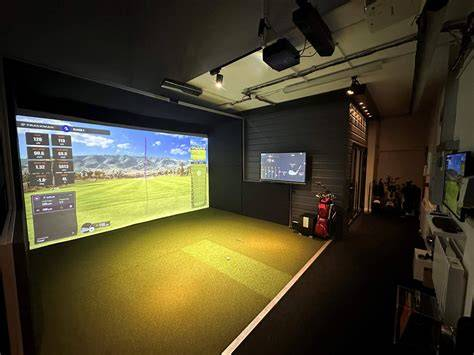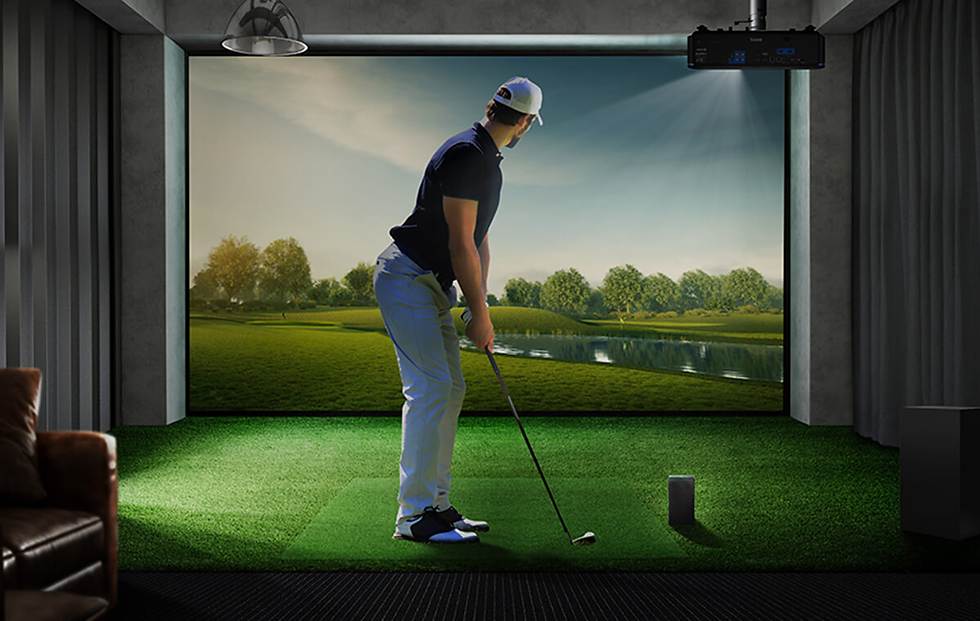What Are the Most Important Features to Look for in a Golf Simulator Projector
- Hoza Mc.Ferdinand
- Aug 11
- 7 min read
Ever stood in Best Buy staring at a wall of projectors, completely overwhelmed by the technical jargon? I've been there! When I was building my first golf simulator, I thought all projectors were basically the same. Boy, was I wrong. After three projector purchases (yes, three!), countless hours of research, and some expensive lessons, I've learned that the most important features to look for in a golf simulator projector can make or break your entire setup.
The difference between a mediocre and amazing golf simulator experience often comes down to choosing the right projector features. Some specs matter way more than others, and some features that sound impressive on paper don't actually improve your golf game at all. Let me save you from the mistakes I made and walk you through what really matters.
1.Brightness and Lumens: Your Foundation for Success

When people ask me about the single most important feature, I always start with brightness. Measured in lumens, this determines whether you'll have a usable image or a washed-out mess that makes tracking your ball impossible.
Here's what I learned the hard way – manufacturers love to advertise peak brightness numbers that you'll never actually achieve in real-world conditions. My first projector claimed 3000 lumens but delivered maybe 2000 lumens after calibration and in normal operating conditions. That shortfall turned my basement simulator into a squinting exercise.
Understanding Real-World Brightness Needs
For dedicated dark rooms, 2500-3000 actual lumens will give you excellent image quality on most screen sizes. But if you're dealing with any ambient light – even small amounts from windows, doorways, or ceiling fixtures – you'll need 3500+ lumens to maintain good contrast and color saturation.
I discovered this during weekend morning sessions when natural light crept into my setup area. What looked amazing at night became barely usable during the day, forcing me to install blackout solutions or upgrade to a brighter projector. The lesson? Always plan for your worst-case lighting scenario, not your best.
The relationship between screen size and brightness requirements is crucial too. Double your screen width, and you need roughly four times the brightness to maintain the same image quality. This is why those 12-foot commercial simulator screens use projectors costing more than most cars!
Brightness Uniformity Across the Screen
Something most people don't consider is brightness uniformity – how evenly the light spreads across your screen. Cheap projectors often have bright centers with dim edges, creating an uneven playing field that affects ball tracking and course visualization.
I spent weeks trying to calibrate my first projector before realizing the issue was fundamental brightness distribution problems. The center was perfect, but the edges were 30% dimmer, making it impossible to track shots that curved toward the screen periphery.
2.Resolution: Clarity That Affects Your Game

Resolution directly impacts your ability to read greens, judge distances, and track ball flight. I've played on everything from 720p to 4K setups, and the differences are significant for serious golf simulation.
1080p should be your minimum standard. The jump from 720p to 1080p is dramatic when you're trying to read subtle green contours or follow your ball's trajectory through trees. Course details that are muddy blobs in 720p become crisp, readable features in 1080p.
Why 4K Might Not Be Worth It
4K sounds impressive, but it's not always the game-changer you'd expect for golf simulation. The benefits are most noticeable on larger screens (10+ feet) and require significantly more processing power from your computer. I tested 4K extensively and found the improvement over good 1080p was nice but not transformative for most home setups.
The bigger consideration is whether your simulation software can actually deliver 4K content. Many popular golf sim programs are optimized for 1080p, so you're not getting additional detail even with a 4K projector. Check your software requirements before paying the 4K premium.
Refresh rate matters more than resolution for golf simulation. Smooth ball tracking requires at least 60Hz, and 120Hz provides noticeably better motion clarity for fast-moving objects like golf balls. I've seen expensive 4K projectors with poor refresh rates that made ball tracking feel laggy and unresponsive.
3.Input Lag: The Hidden Performance Killer
This is the feature most people completely ignore until it ruins their experience. Input lag is the delay between your computer sending an image and the projector displaying it. For golf simulation, this delay can throw off your timing and make the whole experience feel disconnected.
I initially focused on image quality specs and completely overlooked input lag. My first projector had over 100ms of input lag, which made every shot feel slightly delayed and unnatural. Upgrading to a gaming-oriented projector with sub-50ms lag transformed the responsiveness of my entire setup.
Gaming Mode and Low-Latency Features
Look for projectors with dedicated gaming modes or low-latency settings. These modes often sacrifice some image processing for reduced delay, and it's usually worth the trade-off for interactive applications like golf simulation.
Some projectors advertise low input lag but only achieve it in specific modes or with certain input types. Make sure the low-lag performance applies to the resolution and connection method you'll actually use. There's no point in 20ms lag if it only works with 720p input and you need 1080p.
4.Color Accuracy and Contrast: Bringing Courses to Life

Golf courses have subtle color variations that affect depth perception and course reading. Oversaturated or inaccurate colors make everything look artificial and can actually hurt your ability to judge distances and green slopes.
I learned this when playing famous courses I knew well in real life. My first projector made Augusta National look like a cartoon, with impossibly green grass and artificial-looking sand bunkers. The colors were so oversaturated that familiar landmarks looked completely wrong.
Dynamic Range and Shadow Detail
Contrast ratio determines how well you can see details in both bright and dark areas simultaneously. Golf courses have lots of dynamic range – bright sand traps next to dark tree shadows – and poor contrast makes these areas blend together into muddy messes.
Look for projectors with good black levels, not just high peak brightness. A projector that can display true blacks alongside bright whites will give you much better depth perception and course definition than one that crushes all the shadows into gray.
Native contrast is more important than dynamic contrast ratios that manufacturers love to advertise. Dynamic contrast involves adjusting brightness in real-time, which can cause distracting fluctuations during gameplay.
5.Throw Ratio: Matching Your Space Constraints

Throw ratio determines how far back your projector needs to be for a given screen size. This single specification can eliminate entire categories of projectors from consideration based on your room layout.
Short-throw projectors (typically 0.5:1 to 1.0:1 ratios) can create large images from close distances but cost significantly more and often have brightness limitations. Long throw projectors (1.5:1 and higher) are cheaper and brighter, but need more space behind your hitting area.
Zoom and Lens Flexibility
Fixed lens projectors offer the best image quality and brightness but require precise placement. Zoom lenses provide flexibility but often sacrifice some brightness and sharpness, especially at the extreme ends of the zoom range.
I initially chose a projector with 2:1 zoom thinking it would give me maximum flexibility. In reality, I needed to use it at one of the zoom extremes to fit my space, which resulted in noticeably dimmer and softer images than a fixed lens projector optimized for that distance.
Lens shift capabilities let you adjust image position without moving the projector physically. This is incredibly valuable for ceiling-mounted installations where precise positioning is difficult. Keystone correction is a digital alternative, but it reduces resolution and image quality.
6.Connectivity and Future-Proofing
Modern golf simulators require multiple video inputs and various connection types. HDMI is standard, but the version matters enormously for performance and compatibility.
HDMI 2.0 or newer is essential for 4K content and high refresh rates. Older HDMI versions will limit your resolution, refresh rate, or both. I made this mistake with an otherwise excellent projector that couldn't handle 4K at 60Hz due to HDMI 1.4 limitations.
Wireless Connectivity Reality Check
Wireless projection sounds convenient, but I've never had good luck with it for golf simulation. The latency is typically too high for real-time ball tracking, and connection stability can be inconsistent during long play sessions.
Stick with wired connections for primary use and consider wireless as a backup or convenience feature for non-gaming content. The performance penalty isn't worth it for interactive applications where responsiveness matters.
7.Longevity and Maintenance Features

Lamp life directly affects your long-term costs and maintenance schedule. Traditional lamp-based projectors need bulb replacements every 2000-5000 hours, with replacement costs ranging from $200-500 per bulb.
LED and laser projectors cost more upfront but eliminate bulb replacements entirely. For regular simulator use, the total cost of ownership often favors LED/laser options despite higher initial prices.
Filter and Cooling System Design
Dust is the enemy of projector longevity, especially in basements, garages, and other common simulator locations. Look for projectors with easily accessible and cleanable air filters. Some models have sealed optical engines that prevent dust from reaching critical components.
Cooling system design affects both noise levels and component lifespan. Quieter projectors often run cooler and last longer, while loud cooling fans can be distracting during quiet moments in your golf simulation.
8.Audio Integration Capabilities
Built-in speakers are convenient but rarely good enough for immersive golf simulation. However, audio output options and integration capabilities can simplify your overall setup and reduce cable management complexity.
Look for projectors with audio pass-through, multiple audio outputs, or support for wireless audio transmission. These features can eliminate the need for separate audio switching equipment and reduce overall system complexity.
9.Smart Features and Software Integration
Modern projectors often include smart TV functionality, built-in streaming apps, and various software features. While these aren't essential for golf simulation, they can add value for multi-purpose installations.
Some smart features actually interfere with low-latency gaming performance. Automatic image processing, motion smoothing, and other "enhancement" features can add input lag and should typically be disabled for golf simulation use.
The key is understanding which features directly impact your golf simulation experience versus nice-to-have extras that might justify a higher price if you'll use the projector for other purposes too.
Making Feature Priority Decisions
Not every feature matters equally, and trying to maximize everything will blow your budget. Start with the non-negotiables: adequate brightness for your space, appropriate throw ratio for your room, and low enough input lag for responsive gameplay.
Next, prioritize features that directly affect your golf experience: good color accuracy for course realism, sufficient resolution for detail visibility, and reliable connectivity for consistent performance.
Finally, consider convenience and longevity features like LED light sources, quiet operation, and easy maintenance access. These don't directly impact image quality but can significantly affect your long-term satisfaction with the projector.
The perfect golf simulator projector balances all these features within your budget and space constraints. Focus on getting the fundamentals right – brightness, resolution, and responsiveness – then add premium features as your budget allows. A projector that excels at the basics will serve you much better than one with impressive but irrelevant advanced features.




Comments